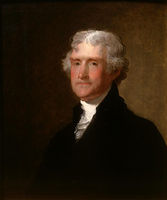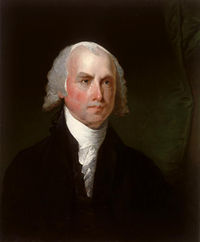Gilbert Stuart
| Gilbert Stuart | |
|---|---|
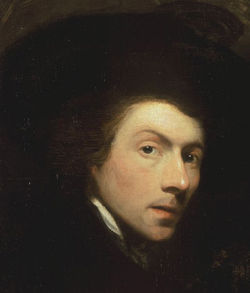 A Self Portrait of Gilbert Stuart, Painted in 1778 |
|
| Birth name | Gilbert Charles Stewart[1] |
| Born | December 3, 1755 Saunderstown, Rhode Island Colony, Colonial America |
| Died | July 9, 1828 (aged 72) Boston, Massachusetts, United States |
| Nationality | American |
| Field | Painting |
| Works | George Washington (The Athenaeum Portrait) (1796) George Washington (Lansdowne portrait) (1796) George Washington (Vaughan Portrait) (1795) The Skater (1782) Self-Portrait (1778) Catherine Brass Yates (1794) John Jay (1794) John Adams (1824) |
Gilbert Charles Stuart (born Stewart) (December 3, 1755 – July 9, 1828) was an American painter from Rhode Island.
Gilbert Stuart is widely considered to be one of America's foremost portraitists.[2] His best known work, the unfinished portrait of George Washington that is sometimes referred to as The Athenaeum, was begun in 1796 and never finished; Stuart retained the portrait and used it to paint 130 copies which he sold for $100 each. The image of George Washington featured in the painting has appeared on the United States one-dollar bill for over a century.[2]
Throughout his career, Gilbert Stuart produced portraits of over 1,000 people, including the first six Presidents of the United States.[3] His work can be found today at art museums across the United States and the United Kingdom, most notably the Metropolitan Museum of Art and Frick Collection in New York City, the National Gallery of Art in Washington, D.C., the National Portrait Gallery in London, and the Museum of Fine Arts in Boston.[4]
Contents |
Biography
Early life

Gilbert Stuart was born in Saunderstown, Rhode Island on December 3, 1755 and baptized at Old Narragansett Church.[5] He was the third son of Gilbert Stewart,[6] a Scottish immigrant employed in the snuff-making industry, and Elizabeth Anthony Stewart, a member of a prominent land-owning family from Middletown, Rhode Island.[3] Stuart's father worked in the first colonial Snuff Mill in America, which was located in the basement of the family homestead.[7]
Gilbert Stuart moved to Newport, Rhode Island at the age of seven, where his father pursued work in the merchant field. In Newport, Stuart first began to show great promise as a painter.[8] He was tutored by Cosmo Alexander, a Scottish painter.[9] Under the guidance of Alexander, Stuart painted the famous portrait Dr. Hunter's Spaniels, which hangs today in the Hunter House Mansion in Newport, when he was twelve years old.[10]
Stuart moved to Scotland with Alexander in 1771 to finish his studies. His mentor died in Edinburgh the following year. Attempting briefly and without success to earn a living as a painter, he returned to Newport in 1773.
England and Ireland
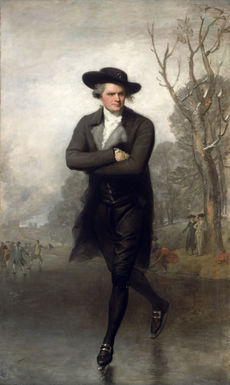
Stuart's prospects as a portraitist were jeopardized by the onset of the American Revolution and its social disruptions. Following the example set by John Singleton Copley, Stuart departed for England in 1775.[11] Unsuccessful at first in pursuit of his vocation, he then became a protegé of Benjamin West, with whom he studied for the next six years. The relationship was a beneficial one, with Stuart exhibiting at the Royal Academy as early as 1777.[11]
By 1782 Stuart had met with success, largely due to acclaim for The Skater, a portrait of William Grant. At one point, the prices for his pictures were exceeded only by those of renowned English artists Joshua Reynolds and Thomas Gainsborough. Despite his many commissions, however, Stuart was habitually neglectful of finances and was in danger of being sent to debtors' prison. In 1787 he fled to Dublin, Ireland, where he painted and accumulated debt with equal vigor.[12]
New York and Philadelphia
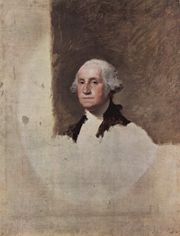
Stuart returned to the United States in 1793, settling briefly in New York City. In 1795 he moved to Germantown, Pennsylvania, near (and now part of) Philadelphia, where he opened a studio.[13][14] It was here that he would gain not only a foothold in the art world, but lasting fame with pictures of many important Americans of the day.
Stuart painted George Washington in a series of iconic portraits, each of them leading in turn to a demand for copies and keeping Stuart busy and highly paid for years.[15] The most famous and celebrated of these likenesses, known as The Athenaeum, is currently portrayed on the United States one dollar bill. Stuart, along with his daughters, painted a total of 130 reproductions of The Athenaeum. However, Stuart never completed the original version; after finishing Washington's face, the artist kept the original version to make the copies.[16] He sold up to 70 of his reproductions for a price of US$100 each, but the original portrait was left unfinished at the time of Stuart's death in 1828.[16] The painting now hangs in Boston's Museum of Fine Arts.[16]
Another celebrated image of Washington is the Lansdowne portrait, a large portrait with one version hanging in the East Room of the White House. During the burning of Washington by British troops in the War of 1812, this picture was saved through the intervention of First Lady Dolley Madison and Paul Jennings, one of President James Madison's slaves. Gilbert painted 12 versions of the portrait throughout his life. Most of the U.S. states feature a copy of the painting hanging in their state capitol. In 1803, Stuart opened a studio in Washington, D. C.[17]
Death in Boston
Stuart moved to Boston in 1805, continuing in critical acclaim and financial troubles. In 1824 he suffered a stroke, which left him partially paralyzed. Nevertheless, Stuart continued to paint for two years until his death in Boston at the age of 72.[18] He was buried in the Old South Burial Ground of the Boston Common. As Stuart left his family deeply in debt, his wife and daughters were unable to purchase a grave site. Stuart was therefore buried in an unmarked grave which was purchased cheaply from Benjamin Howland, a local carpenter.[19] When Stuart's family recovered from their financial troubles roughly ten years later, they planned to move his body to a family cemetery in Newport, Rhode Island. However, since his family could not remember the exact location of Stuart's body, it was never moved.[20]
Controversy
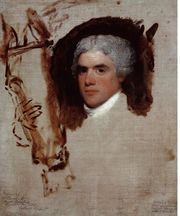
At present there is some debate as to the identity of the sitter for one of Stuart's unfinished portraits.[21][22] In 1878 the portrait of "John Bill Ricketts" was identified by George Washington Riggs, (also known as "The President's Banker"), a trustee of the Corcoran Gallery of Art in Washington, D.C., as "Breschard, the Circus Rider" and as ""Breschard" the painting was displayed at the Museum of Fine Arts, Boston in 1880.[23][24]
Stuart and Ricketts did not sail from Dublin to Philadelphia together as some have claimed,[25]. Owing to Stuart's aversion to being cooped up for weeks with a circus, he booked passage on another ship, the Draper, even though its destination was a different American port.
Peter Grain is cited in the NGA provenance for this painting as being the owner in the mid-1800s. A former member of the Circus of Pépin and Breschard, Grain certainly would have been able to identify the sitter in Stuart's portrait as being Jean Baptiste Casmiere Breschard. Grain sold the portrait to George Washington Riggs.
However, in 1970 the National Gallery of Art changed the identification from "Breschard" " to "Ricketts" and to this day the NGA has failed to explain the reason for this identity change.[26]
Legacy
.jpg)
By the end of his career, Gilbert Stuart had taken the likenesses of over one thousand American political and social figures.[27] He was praised for the vitality and naturalness of his portraits, and his subjects found his company agreeable:
Speaking generally, no penance is like having one's picture done. You must sit in a constrained and unnatural position, which is a trial to the temper. But I should like to sit to Stuart from the first of January to the last of December, for he lets me do just what I please, and keeps me constantly amused by his conversation.
– John Adams[28]
Stuart was known for working without the aid of sketches, beginning directly upon the canvas. This was very unusual for the time period.
Stuart's works can be found today at art museums and private collections throughout the United States and Great Britain, including the University Club in New York City, the Metropolitan Museum of Art in New York City, the National Gallery of Art in Washington, D.C., the National Portrait Gallery in London, and the Museum of Fine Arts in Boston.[4]

In 1940 the U.S. Post Office issued a series of Postage stamps called the 'Famous Americans Series' commemorating famous Artists, Authors, Inventors, Scientists, Poets, Educators and Musicians. Along with the artists James McNeil Whistler, Augustus Saint-Gaudens, Daniel Chester French and Frederick Remington, Gilbert Stuart is found on the 1 cent issue in the Artists category.
Today, Stuart's birthplace in Saunderstown, Rhode Island is open to the public as the Gilbert Stuart Birthplace and Museum. The museum consists of the original house Stuart was born in, with copies of paintings from throughout his career hanging throughout the house. The museum opened in 1930.[29]
Famous people painted
- Abigail Adams - Second First Lady of the United States, wife of John Adams
- John Adams - Second President of the United States
- John Quincy Adams - Sixth President of the United States
- John Bannister - Owner of Bannister's Wharf in Newport, Rhode Island
- Commodore John Barry - Father of the American Navy
- Ann Willing Bingham - Philadelphia socialite
- Horace Binney - Prominent Philadelphia lawyer[30]
- Jean Baptiste Casmiere Breschard - Performer and theatrical impresario

- John Singleton Copley - American colonial portraitist
- Horatio Gates - American Revolutionary War general[30]
- King George III - King of United Kingdom of Great Britain and Ireland, 1760 - 1820[30]
- John Jay - First Chief Justice of the United States Supreme Court
- Thomas Jefferson - Third President of the United States
- Rufus King - a signer of United States Constitution.
- Robert Kingsmill - Admiral in Royal Navy during American and French Revolutionary Wars
- King Louis XVI - King of France, 1774 - 1792[30]
- James Madison - Fourth President] of the United States
- Catherine Wister Miles - Wife of Samuel Miles - Revolutionary War General and Philadelphia Mayor (1790)
- Samuel Miles - Revolutionary War General, Philadelphia Mayor, and America's first faithless elector
- James Monroe - Fifth President of the United States
- Joshua Reynolds - English artist
- John Bill Ricketts - Founder of first circus in the United States
- George Washington - First President of the United States
- Martha Washington - First First Lady of the United States, wife of George Washington
- Benjamin West - American painter
- Catherine Brass Yates - Philadelphia socialite
Portrait Gallery
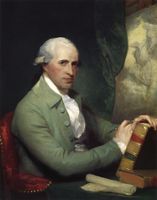 American artist Benjamin West, 1783-84 |
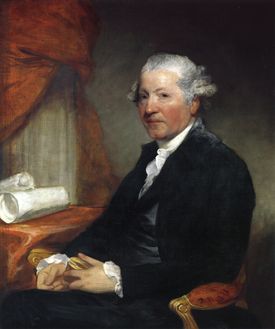 English artist Joshua Reynolds, 1784 |
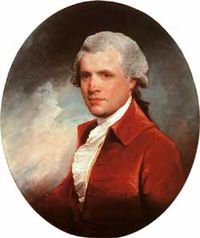 American artist John Singleton Copley, c. 1784 |
 American artist John Trumbull, c. 1818 |
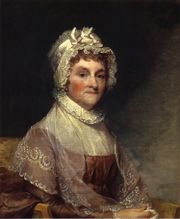 The second First Lady of the United States, Abigail Adams, c. 1800-1815 |
 Robert R. Livingston, diplomat and Founding Father, 1793-1794 |
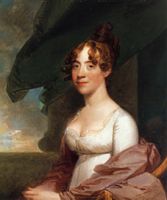 Anna Payne Cutts, sister of First Lady Dolley Madison, 1804, The White House |
|
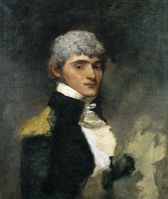 Jérôme Bonaparte, brother of Napoleon Bonaparte, 1804 |
|||
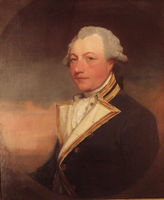 Sir Robert Kingsmill, Admiral in Royal Navy during American and French Revolutionary Wars |
 The sixth President of the United States, John Quincy Adams, 1818. Son of John and Abigail Adams. |
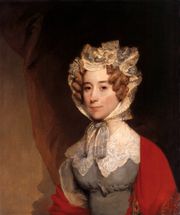 The sixth First Lady of the United States, Louisa Catherine Adams c. 1821-26, Daughter-in law of John and Abigail Adams. |
References
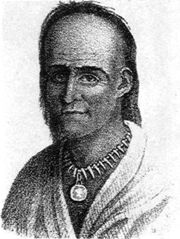
- ↑ "Gilbert Stuart (1775–1828)". Worcester Art Museum. http://www.worcesterart.org/Collection/Early_American/Artists/stuart/biography/index.html. Retrieved 2008-02-04.
- ↑ 2.0 2.1 Gilbert Stuart Birthplace and Museum. Gilbert Stuart Biography. Accessed July 24, 2007.
- ↑ 3.0 3.1 Gilbert Stuart Birthplace, The Story of Gilbert Stuart. Woonsocket Connection. Retrieved on July 25, 2007.
- ↑ 4.0 4.1 ArtCyclopedia. Gilbert Stuart. Paintings in Museums and Public Art Galleries. Accessed July 24, 2007.
- ↑ Rhode Island Unwind. Gilbert Stuart Birthplace. Accessed: July 28, 2007.
- ↑ NNDB. Gilbert Stuart. Father. Accessed: July 25, 2007.
- ↑ McLanathan, Richard. Gilbert Stuart. New York: Harry N. Abrams Inc., 1986. p13
- ↑ Gilbert Stuart Birthplace. Gilbert Stuart. Accessed: July 28, 2007.
- ↑ National Gallery of Art. Gilbert Stuart. Newport and Edinburgh (1755-1775). Accessed: July 28, 2007.
- ↑ Woonsocket: My home town on the web. Rhode Island. Gilbert Stuart. Accessed: July 25, 2007.
- ↑ 11.0 11.1 National Gallery of Art. Gilbert Stuart. London (1775-1787). Accessed: July 31, 2007.
- ↑ National Gallery of Art. Gilbert Stuart. Dublin (1787-1793). Accessed: July 31, 2007.
- ↑ "Gilbert Stuart - Washington". AMERICANREVOLUTION.ORG. http://www.americanrevolution.org/washstu.html. Retrieved 2007-11-25.
- ↑ "George Washington". Smithsonian Institution. http://www.npg.si.edu/exh/hall2/georges.htm. Retrieved 2007-11-25.
- ↑ National Gallery of Art. Gilbert Stuart. Philadelphia (1794-1803). Accessed: July 31, 2007.
- ↑ 16.0 16.1 16.2 Wallechinsky, David and Irving Wallace. "Unfinished Art: Gilbert Stuart's Portrait of George Washington". The People's Almanac. Trivia-Library.com. http://www.trivia-library.com/c/unfinished-art-gilbert-stuart-portrait-of-george-washington.htm. Retrieved 2008-04-21.
- ↑ National Gallery of Art. Gilbert Stuart. Washington, D.C. (1803-1805). Accessed: July 31, 2007.
- ↑ McLanathan, Gilbert Stuart, p148
- ↑ McLanathan, Gilbert Stuart, p150
- ↑ Wolpaw, Jim. Gilbert Stuart: A Portrait from Life (9-Minute Trailer). Documentary.
- ↑ Havard, Bernard and Sylvester, Mark D. Walnut Street Theatre. Charleston: Arcadia Publishing, 2008. p9
- ↑ Google BooksWalnut Street Theatre
- ↑ Mason, George C. The Life and Works of Gilbert Stuart. New York: Charles Scribner's Sons, 1879.
- ↑ Google Books The Life and Works of Gilbert Stuart
- ↑ Howard, Hugh The Painter's Chair, p174. New York: Bloomsbury Press, 2009
- ↑ National Gallery of Art. John Bill Ricketts, 1795/1799. Accessed: July 24, 2007.
- ↑ "Gilbert Stuart". www.gilbertstuartmuseum.com. http://www.gilbertstuartmuseum.com/gilbertstuart.htm. Retrieved 2009-07-16.
- ↑ McLanathan, Gilbert Stuart, p147
- ↑ "Gilbert Stuart Birthplace and Museum". www.gilbertstuartmuseum.com. http://www.gilbertstuartmuseum.com/. Retrieved 2009-07-16.
- ↑ 30.0 30.1 30.2 30.3 NNDB, Gilbert Stuart, Executive Summary. Accessed: July 25, 2007.
- ↑ Carter, Life and Times, 62–3.
External links
- Gilbert Stuart at the National Gallery of Art, Washington
- Gilbert Stuart Museum Website
- www.Gilbert-Stuart.org 155 works by Gilbert Stuart
- Gilbert Stuart on ArtCyclopedia
- Union List of Artist Names, Getty Vocabularies. ULAN Full Record Display for Gilbert Stuart. Getty Vocabulary Program, Getty Research Institute. Los Angeles, California.

